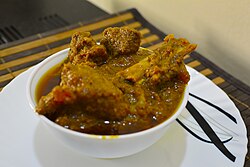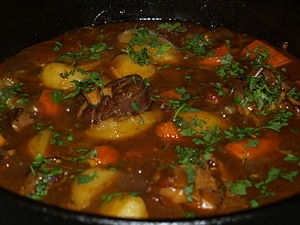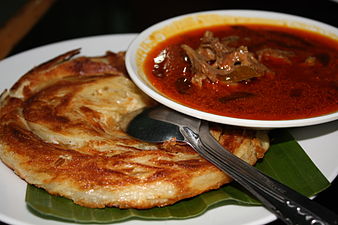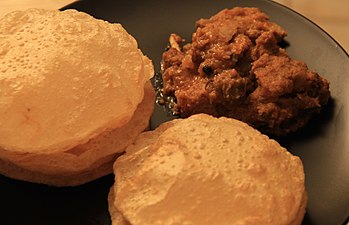Mutton curry
 | |
| Alternative names | Kosha Mangso |
|---|---|
| Type | Curry |
| Course | Main course |
| Place of origin | India, Bangladesh |
| Region or state | Indian subcontinent |
| Associated national cuisine | India, Bangladesh |
| Serving temperature | Hot |
| Main ingredients | Goat meat/Mutton, Tomato, Onion, Garlic, Ginger, Coriander leaves, Indian spices |
| This article is part of the series on |
| Indian cuisine |
|---|
 |
|
|
Mutton curry (also referred to as kosha mangsho,[1] lamb curry,[2] or goat curry[3][4]) is a dish that is prepared from Goat Meat (or sometimes Lamb meat ) and vegetables.[5] The dish is found in different variations across all states, countries and regions of South Asia.
Mutton curry was originally prepared putting all the ingredients together in a earthen pot and slow cooking the whole curry by wood fire on a clay oven.[6] Today it is cooked using pressure cookers and slow cookers after briefly sautéing all the ingredients and spices in a big wok.[6] The slow cooked mutton becomes more tender than normally cooked mutton. Mutton curry is generally served with rice or with Indian breads, such as naan or parotta.[7] The dish can also be served with ragi, a cereal.[8]
Ingredients[edit | edit source]
Common ingredients used to prepare mutton curry include: mutton or goat meat, salt, turmeric powder, mustard oil, ginger garlic paste, dahi (yogurt), assortment of spices, onion, Chilli, tomato, and Coriander leaves.[9]
Variations[edit | edit source]
Kashmir[edit | edit source]
Mutton is a central part of Kashmiri cuisine. Both Hindus and Muslims prepare the same dishes but with different spices. While Kashmiri Muslims use onion and garlic in their dishes, the Kashmiri Hindus use hing and ginger powder instead of onion and garlic to increase the flavour of their dishes. Most of the mutton dishes are part of Wazwan, a meal of 36 courses which is served during weddings. Some of the important dishes include:
- Rista (meatballs in a fiery red gravy)
- Lahabi kabab or Moachi kabab (flattened mutton kababs cooked in yogurt)
- Daeni phoul (mutton dish)
- Doudha ras (mutton cooked in sweet milk gravy)
- Rogan josh (tender lamb cooked with Kashmiri spices)
- Tabak maaz (ribs of lamb simmered in yogurt till tender, then fried)
- Daniwal korma (a mutton curry with coriander)
- Waza palak (green spinach cooked with small mutton balls known as paliki riste)
- Aab gosh (lamb cooked in milk curry)
- Marchwangan korma (an extremely spicy lamb dish)
- Kabab (minced meat roasted on skewers over hot coals)
- Gushtaba (a velvety textured meatball in white yogurt gravy)
Odisha[edit | edit source]
In Odisha mutton curry is always made of khasi goat meat (meat of young castrated male goat). There are many varieties of goat meat curries that are prepared in Odisha. Some of the popular curries are:[10]
- Mutton Kawsa (Odia: ମାଂସ କସା mangsaw kawsa)
- Mutton Curry (Odia: ମାଂସ ତରକାରୀ mangsaw tarkari)
- Mutton Roasted in Bamboo or Bamboo Mutton (Odia: ବାଉଁଶ ପୋଡା ମାଂସ baunsaw poda mangsaw)
- Mutton Roasted in Leaf (Odia: ପତ୍ର ପୋଡା ମାଂସ patra poda mangsaw)
- Mutton in Clay Pot (Odia: ମାଟି ହାଣ୍ଡି ମାଂସ mati handi mangsaw)
- Mutton Besaraw (Odia: ମାଂସ ବେସର mangsaw besaraw)
While mutton curry is usually eaten with rice, in Western Odisha Mangsaw Kawsa is particularly relished with mudhi (puffed rice). Mangsaw Kawsa is said to be the predecessor of the popular Bengali goat curry dish known as Kosha Mangsho most probably introduced by the Odia cooks who moved to West Bengal during the British rule to work in the kitchens of Bengali families.[11]
West Bengal[edit | edit source]
Kosha mangsho is the Bengali version of mutton curry. It traditionally has less juice and more gravy than mutton curries eaten in other parts of India.[12] This dish is prepared in a kosha style, which involves retaining the mutton's flavor and moisture using slow cooking and sautéeing methods.[13]
Kosha mangsho is traditionally prepared as part of the celebration of Kali Puja,[14] a festival dedicated to the Hindu goddess Kali, celebrated on the New Moon day of the Hindu month Kartik.
Railway mutton curry is a British Raj colonial-era dish that was served on long distance trains.[15][16][17] The dish was served with dinner rolls.[15] Tamarind was originally used to extend its shelf life.[15] Some restaurants serve the dish in present-day times, such as Oh! Calcutta! restaurant in Kolkata, India.[18][19] Railway mutton curry is prepared using a coconut milk base.[19]
- Mutton curry variations
Roti cane with mutton curry (top)
Counterfeit variations[edit | edit source]
In 2012, in The Midlands, England, trading standards officers working undercover went to twenty restaurants that were randomly chosen and bought 39 lamb curry and kebab dishes.[20] Four of the dishes contained no lamb, instead using a mixture that contained beef, pork or chicken.[20] In the investigation, it was found that only three lamb curries out of the nineteen tested contained only lamb. Most were found to consist of a mixture of lamb with beef or chicken.[20] Additionally, all of the twenty lamb kebabs that were sampled contained meats in addition to lamb that was mixed with it, such as beef, pork or chicken.[20]
See also[edit | edit source]
References[edit | edit source]
- ↑ Mazumdar, Arunima (11 April 2015). "Bengali recipe: Kosha Mangsho". The Times of India. Retrieved 10 May 2015.
- ↑ "Rick Stein's perfect Indian recipes". NewsComAu. 10 May 2015. Retrieved 10 May 2015.
- ↑ Cooking time Prep: 25 mins Cook: 3 hrs. "Goat curry". BBC Good Food. Retrieved 5 September 2015.
- ↑ "Goat (Mutton) Curry Recipe". Indianfood.about.com. Retrieved 5 September 2015.
- ↑ Smith, Charmian (23 March 2011). "Video: How to make Indian-style mutton curry". Otago Daily Times. Retrieved 8 May 2015.
- ↑ 6.0 6.1 Sen, Rajyasree (29 September 2014). "Mutton Curry and Coconut Prawn Recipes for the Durga Pujo Festival". The Wall Street Journal. Retrieved 8 May 2015.
- ↑ Ray, Bikramjit (13 February 2015). "Mutton of the matter". The Hindu Business Line. Retrieved 8 May 2015.
- ↑ Krishna, Geetanjali (25 March 2011). "Geetanjali Krishna: Ragi makes a comeback". Sify. Retrieved 10 May 2015.
- ↑ Das, Soumitra (29 April 2015). "Recipe: Mutton curry in mustard oil". Times of India. Retrieved 8 May 2015.
- ↑ "Mangsha Besara". December 4, 2017.
- ↑ "Is Odisha India's most underrated food destination?". Condé Nast Traveller India. December 15, 2017.
- ↑ Sanghvi, Vir (29 June 2014). "India's greatest mutton curry". Hindustan Times. Archived from the original on January 21, 2015. Retrieved 8 May 2015.
- ↑ "Delectable Bengali foods to tuck into on Poila Boishakh". The Times of India. 15 April 2015. Retrieved 10 May 2015.
- ↑ "Kosha mangsho and Bhoot Chaturdashi: Celebrating Kali Puja and Diwali, Bengali style". Firstpost. 22 October 2014. Retrieved 10 May 2015.
- ↑ 15.0 15.1 15.2 Chatterjee, A. (2013). Oh! Calcutta: Cookbook. Random House India. ISBN 978-81-8400-456-4.
- ↑ Time Out India: Perfect Places to Stay, Eat and Explore. Perfect Places Series. Time Out Guides. 2010. p. 81. ISBN 978-1-84670-164-1. Retrieved 10 May 2015.
- ↑ Fodor's Essential India: with Delhi, Rajasthan, Mumbai & Kerala. Full-color Travel Guide. Fodor's Travel Publications. 2015. p. 785. ISBN 978-1-101-87868-2.
- ↑ Bhandari, R. (2013). The Raj on the Move. Roli Books Pvt. Ltd. ISBN 978-93-5194-037-1.
- ↑ 19.0 19.1 Brien, C.O. (2013). The Penguin Food Guide to India. Penguin Books Limited. p. 175. ISBN 978-93-5118-575-8.
- ↑ 20.0 20.1 20.2 20.3 Food (30 April 2012). "Lamb curry contains no lamb, trading standards warn". Telegraph.co.uk. Retrieved 10 May 2015.
External links[edit | edit source]
- "From Railway Mutton curry to Bedmi-aloo: When railway food was an affair to remember". The Indian Express.
- "Main Dishes of Odisha". odishatourguide.com.












